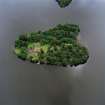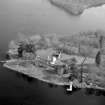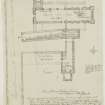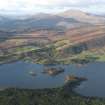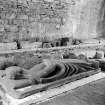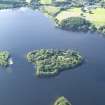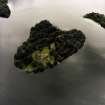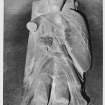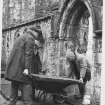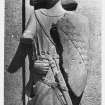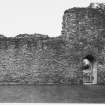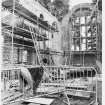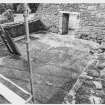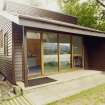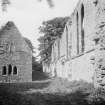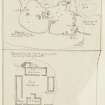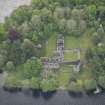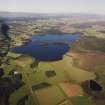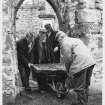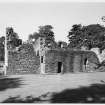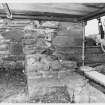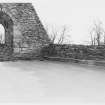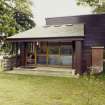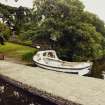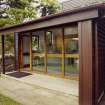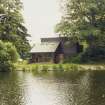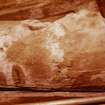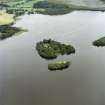Pricing Change
New pricing for orders of material from this site will come into place shortly. Charges for supply of digital images, digitisation on demand, prints and licensing will be altered.
Lake Of Menteith, Inchmahome Priory
Priory (Medieval)
Site Name Lake Of Menteith, Inchmahome Priory
Classification Priory (Medieval)
Alternative Name(s) Inchmahome Abbey
Canmore ID 24063
Site Number NN50SE 4
NGR NN 57431 00547
Datum OSGB36 - NGR
Permalink http://canmore.org.uk/site/24063
First 100 images shown. See the Collections panel (below) for a link to all digital images.
- Council Stirling
- Parish Port Of Menteith
- Former Region Central
- Former District Stirling
- Former County Perthshire
(NN 5743 0054) Remains of Priory (NR)
(Augustinian. Founded AD 1238) (NAT).
OS 6"map, (1958).
The Priory of Inchmahome, founded 1238 - Description, history, and plan.
J S Richardson 1947.
Inchmahome Priory is as described and planned by MoW.
Visited by OS (RD) 18 October 1968.
Paper clipping.
Scots Magazine, October 1980.
NN 5743 0054 The excavation of a small hole, dug to receive a memorial tree, was monitored in October 1999. The excavations lay towards the N shore of the island, with the hole being located at a point 9m N of the foot of the mound immediately to the NE of the nave of the priory church (NMRS NN50SE 4). The hole lay beyond (N of) the limits of maintained land, within a narrow boundary strip leading to the shoreline, and was excavated to a depth of 450mm. A rubble deposit was located, appearing to derive from the demolition of priory buildings, possibly emanating from buildings on the N side of the nave, which have been totally removed. The level area and mound appear to have resulted from extensive landscaping. Whether these features represent part of the later plantation over the island, or part of earlier occupation, is not known. No finds were recovered.
Sponsor: Historic Scotland
G Ewart 2000
Records held at National Archives of Scotland:
GD/220/6/934/15
Isle of Menteith. Repair of the slate roof of the Earl of Menteith's burial place. Item included in work undertaken by Robert McFarlane, slater in Doune. Receipted account, 1716
GD/220/6/936/4
Door for Earl of Monteith's burial place. Receipted account for work undertaken by John Grahame, wright at Port, 1718
The National Library of Scotland, Edinburgh
Amoung the 'Uncatalogued MSS of General Hutton', volume 1, 113-14, a ground plan and W view dated 1789.
Despite the modest scale of the trenching and landscape analysis, this programme of work on Inchmahome has confirmed the preservation and unique character of a complex and rich history. Although a detailed chronology is not clear at present it is fair to say that the archaeology, ocumentation, topography and plantation of Inchmahome define a series of frames of reference which cumulatively and individually represent a consistent and well preserved pattern of settlement and land use over an extended period. It is equally apparent that no one aspect of the island archaeological resource, whether standing remains, tree cover, ecology, hydrology, etc. of the island can be best understood in isolation. In turn, Inchmahome is only one element within a complex of islands in the Lake of Menteith, all of which are associated, if only by being in the same relatively small body of water and subject to the same nvironmental/hydrological factors.
Information from OASIS Id: kirkdale1-505098 (G Ewart) 2010
Field Visit (August 1978)
Inchmahome Priory NN 574 005 NN50SE 4
The ruins of the Augustinian priory of Inchmahome stand on an island in the Lake of Menteith. It was founded in 1238.
RCAHMS 1979, visited August 1978
(Richardson 1978)
Publication Account (1985)
There are two islands in the Lake of Menteith; the smaller is occupied by the Castle of Inchtalla, while the larger houses the Priory ofInchmahome, which must be one of Scotland's most attractively sited monuments. The Augustinian Priory was founded in 1238 by WalterComyn, 4th Earl of Menteith, but there may have been an Early Christian monastery on the island. All that remains to be seen of the latter establishment, however, is a rather poorly carved slab preserved in the Chapter House. The Priory remained in ecclesiastical hands until the early 16th century when the land was leased to a lay family, after which it became, to all intents and purposes, the heritable property of the Erskines. Following the battle of Pinkie (1547), the young Queen Mary and her mother were lodged for safe-keeping with the monks at Inchmahome for three weeks, but by the end of that century the island had lost its religious community.
Although the Priory is now in ruinous condition, enough survives to give a vivid picture of this compact religious house with its spacious church and conventual buildings ranged around the cloister. Building and remodelling continued over a long period, and this is particularly noticeable at the west end of the church where a square bell-tower was added in the late medieval period, and on the south of the cloisters where the foundations of an earlier range of buildings have been exposed. Some of the piers and the west doorway of the church show marked similarities to work at Dunblane Cathedral (no. 51), which was under construction at about the same time, and it is possible that some of the masons were involved in both projects. Originally there was a group of medieval grave-markers and effigies in the church but most have now been moved to the Chapter House for greater protection.
During the medieval period the monks cultivated parts of the island, and traces of field banks and other enclosures can still be seen; on the west of the island there is a small knot garden Ccfthe much more elaborate example at the King's Knot, Stirling, no. 15) which is traditionally, but probably erroneously, associated with Mary, Queen of Scots.
Information from ‘Exploring Scotland’s Heritage: The Clyde Estuary and Central Region’, (1985).
Watching Brief (28 October 1999)
The excavation of a small hole, dug to receive a memorial tree, was monitored in October 1999. The excavations lay towards the N shore of the island, with the hole being located at a point 9m N of the foot of the mound immediately to the NE of the nave of the priory church. The hole lay beyond (N of) the limits of maintained land, within a narrow boundary strip leading to the shoreline, and was excavated to a depth of 450mm. A rubble deposit was located, appearing to derive from the demolition of priory buildings, possibly emanating from buildings on the N side of the nave, which have been totally removed. The level area and mound appear to have resulted from extensive landscaping. Whether these features represent part of the later plantation over the island, or part of earlier occupation, is not known. No finds were recovered.
Sponsor: Historic Scotland
G Ewart
Kirkdale Archaeology
Field Visit (13 July 2010)
NN 5738 0043 and NN 5748 0043 (centred on) A site visit was made on 13 July 2010 to two areas where green glaze pottery and a large amount of glass, ceramic and iron had been recovered following a drop in the water level of the Lake of Menteith. Amongst the material recovered were three sherds of water rolled green glaze pottery, several pieces of WW2 corkscrew-and-loop iron uprights for a barbed wire fence, bottle and teacup ceramics, and numerous pieces of glass.
P Fox 2010
Funder: Historic Scotland
Kirkdale Archaeology
OASIS Id: kirkdale1-279388
Excavation (10 May 2010 - 2 June 2010)
Kirkdale Archaeology was required by Historic Scotland to excavate two trenches at Inchmahome Priory, situated on the Lake of Menteith. The trenches were primarily to take two new earthfast interpretation signs. Despite the modest scale of the trenching and landscape analysis, this programme of work on Inchmahome has confirmed the preservation and unique character of a complex and rich history.
G Ewart 2010
Sponsor: Historic Scotland
Kirkdale Archaeology
OASIS Id: kirkdale1-505098
Measured Survey
Drawings by R Campbell in the National Art Survey of Scotland Collection.










































































































